Effect of Deformation-Induced Plasticity in Low-Alloyed Al-Mg-Zr Alloy Processed by High-Pressure Torsion
Abstract
:1. Introduction
2. Materials and Methods
3. Results
3.1. Mechanical Properties and Electrical Conductivity
3.2. Microstructure Characterization
4. Discussion
5. Conclusions
Author Contributions
Funding
Data Availability Statement
Conflicts of Interest
References
- Yuan, W.; Liang, Z.; Zhang, C.; Wei, L. Effects of La addition on the mechanical properties and thermal-resistant properties of Al–Mg–Si–Zr alloys based on AA 6201. Mater. Des. 2012, 34, 788–792. [Google Scholar] [CrossRef]
- Yoshida, K.; Doi, K. Improvement of ductility of aluminum wire for automotive wiring harness by alternate drawing. Procedia Eng. 2014, 81, 706–711. [Google Scholar] [CrossRef]
- Polmear, I.J. Light Alloys: From Traditional Alloys to Nanocrystals, 3rd ed.; Butterworth-Heinemann/Elsevier: Oxford, UK, 2006; p. 421. [Google Scholar]
- Changela, K.; Krishnaswamy, H.; Digavalli, R.K. Development of combined groove pressing and rolling to produce ultra-fine grained Al alloys and comparison with cryorolling. Mater. Sci. Eng. A 2019, 760, 7–18. [Google Scholar] [CrossRef]
- Yang, B.; Wang, Y.; Gao, M.; Wang, C.; Guan, R. Microstructural evolution and strengthening mechanism of Al–Mg alloys with fine grains processed by accumulative continuous extrusion forming. J. Mater. Sci. Technol. 2022, 128, 195–204. [Google Scholar] [CrossRef]
- Valiev, R.Z.; Straumal, B.; Langdon, T.G. Using Severe Plastic Deformation to Produce Nanostructured Materials with Superior Properties. Annu. Rev. Mater. Res. 2022, 52, 357–382. [Google Scholar] [CrossRef]
- Zhilyaev, A.P.; Torres, M.J.; Cadena, H.D.; Rodriguez, S.L.; Calvo, J.; Cabrera, J.M. The effect of pre-annealing on the evolution of the microstructure and mechanical behavior of aluminum processed by a novel SPD method. Materials 2020, 13, 2361. [Google Scholar] [CrossRef]
- Radhi, H.N.; Aljassani, A.M.; Mohammed, M.T. Effect of ECAP on microstructure, mechanical and tribological properties of aluminum and brass alloys: A review. Mater. Today Proc. 2020, 26, 2302–2307. [Google Scholar] [CrossRef]
- Mathew, R.T.; Singam, S.; Ghosh, P.; Masa, S.K.; Prasad, M.J.N.V. The defining role of initial microstructure and processing temperature on microstructural evolution, hardness and tensile response of Al-Mg-Sc-Zr (AA5024) alloy processed by high pressure torsion. J. Alloys Compd. 2022, 901, 163548. [Google Scholar] [CrossRef]
- Agarwal, K.M.; Tyagi, R.K.; Choubey, V.; Saxena, K.K. Mechanical behaviour of Aluminium Alloy AA6063 processed through ECAP with optimum die design parameters. Adv. Mater. Process. Technol. 2022, 8, 1901–1915. [Google Scholar] [CrossRef]
- Murashkin, M.Y.; Enikeev, N.A.; Sauvage, X. Potency of Severe Plastic Deformation Processes for Optimizing Combinations of Strength and Electrical Conductivity of Lightweight Al-Based Conductor Alloys. Mater. Trans. 2023, 64, 1833–1843. [Google Scholar] [CrossRef]
- Mckenzie, P.W.J.; Lapovok, R. ECAP with back pressure for optimum strength and ductility in aluminium alloy 6016. Part 2: Mechanical properties and texture. Acta Mater. 2010, 58, 3212–3222. [Google Scholar] [CrossRef]
- Orlova, T.S.; Sadykov, D.I.; Danilov, D.V.; Murashkin, M.Y. Influence of decreased temperature on the plasticization effect in high-strength Al-Cu-Zr alloy. J. Alloys Compd. 2023, 931, 167540. [Google Scholar] [CrossRef]
- Medvedev, A.E.; Murashkin, M.Y.; Enikeev, N.A.; Valiev, R.Z.; Hodgson, P.D.; Lapovok, R. Optimization of Strength-Electrical Conductivity Properties in Al–2Fe Alloy by Severe Plastic Deformation and Heat Treatment. Adv. Eng. Mater. 2018, 20, 1700867. [Google Scholar] [CrossRef]
- Cubero-Sesin, J.M.; Arita, M.; Horita, Z. High Strength and Electrical Conductivity of Al-Fe Alloys Produced by Synergistic Combination of High-Pressure Torsion and Aging. Adv. Eng. Mater. 2015, 17, 1792–1803. [Google Scholar] [CrossRef]
- Andreau, O.; Gubicza, J.; Zhang, N.X.; Huang, Y.; Jenei, P.; Langdon, T.G. Effect of short-term annealing on the microstructures and flow properties of an Al–1% Mg alloy processed by high-pressure torsion. Mater. Sci. Eng. A 2014, 615, 231–239. [Google Scholar] [CrossRef]
- Attarilar, S.; Ebrahimi, M.; Hsieh, T.H.; Uan, J.Y.; Göde, C. An insight into the vibration-assisted rolling of AA5052 aluminum alloy: Tensile strength, deformation microstructure, and texture evolution. Mater. Sci. Eng. A 2021, 803, 140489. [Google Scholar] [CrossRef]
- Gubicza, J.; Chinh, N.Q.; Horita, Z.; Langdon, T.G. Effect of Mg addition on microstructure and mechanical properties of aluminum. Mater. Sci. Eng. A 2004, 387–389, 55–59. [Google Scholar] [CrossRef]
- Zhang, J.; Starink, M.J.; Gao, N.; Zhou, W. Effect of Mg addition on strengthening of aluminium alloys subjected to different strain paths in high pressure torsion. Mater. Sci. Eng. A 2011, 528, 2093–2099. [Google Scholar] [CrossRef]
- Zha, M.; Li, Y.; Mathiesen, R.H.; Bjørge, R.; Roven, H.J. Achieve high ductility and strength in an Al-Mg alloy by severe plastic deformation combined with inter-pass annealing. Mater. Sci. Eng. A 2014, 598, 141–146. [Google Scholar] [CrossRef]
- Murashkin, M.Y.; Medvedev, A.E.; Kazykhanov, V.U.; Raab, G.I.; Ovid’ko, I.A.; Valiev, R.Z. Microstructure, strength, electrical conductivity and heat resistance of an Al-Mg-Zr alloy after ECAP-conform and cold drawing. Rev. Adv. Mater. Sci. 2016, 47, 16–25. [Google Scholar]
- Orlova, T.S.; Latynina, T.A.; Murashkin, M.Y.; Chabanais, F.; Rigutti, L.; Lefebvre, W. Effects of Mg on strengthening mechanisms in ultrafine-grained Al–Mg–Zr alloy. J. Alloys Compd. 2021, 859, 157775. [Google Scholar] [CrossRef]
- Masuda, T.; Sauvage, X.; Hirosawa, S.; Horita, Z. Achieving highly strengthened Al–Cu–Mg alloy by grain refinement and grain boundary segregation. Mater. Sci. Eng. A 2020, 793, 139668. [Google Scholar] [CrossRef]
- Huang, X.; Hansen, N.; Tsuji, N. Hardening by annealing and softening by deformation in nanostructured metals. Science 2006, 312, 249–251. [Google Scholar] [CrossRef] [PubMed]
- Terada, D.; Houda, H.; Tsuji, N. Effect of strain on “hardening by annealing and softening by deformation” phenomena in ultra-fine grained aluminum. J. Mater. Sci. 2008, 43, 7331–7337. [Google Scholar] [CrossRef]
- Orlova, T.S.; Skiba, N.V.; Mavlyutov, A.M.; Murashkin, M.Y.; Valiev, R.Z.; Gutkin, M.Y. Hardening by annealing and implementation of high ductility of ultrafine grained aluminum: Experiment and theory. Rev. Adv. Mater. Sci. 2018, 57, 224–240. [Google Scholar] [CrossRef]
- Orlova, T.S.; Mavlyutov, A.M.; Murashkin, M.Y.; Enikeev, N.A.; Evstifeev, A.D.; Sadykov, D.I.; Gutkin, M.Y. Influence of decreased temperature of tensile testing on the annealing-induced hardening and deformation-induced softening effects in ultrafine-grained Al–0.4Zr alloy. Materials 2022, 15, 8429. [Google Scholar] [CrossRef]
- Renk, O.; Pippan, R. Anneal Hardening in Single Phase Nanostructured Metals. Mater. Trans. 2023, 64, 1464–1473. [Google Scholar] [CrossRef]
- Belov, N.A.; Korotkova, N.O.; Akopyan, T.K.; Timofeev, V.N. Structure and Properties of Al-0.6%Zr-0.4%Fe-0.4%Si (wt.%) Wire Alloy Manufactured by Electromagnetic Casting. JOM 2020, 72, 1561–1570. [Google Scholar] [CrossRef]
- Çadırlı, E.; Tecer, H.; Şahin, M.; Yılmaz, E.; Kırındı, T.; Gündüz, M. Effect of heat treatments on the microhardness and tensile strength of Al-0.25 wt% Zr alloy. J. Alloys Compd. 2015, 632, 229–237. [Google Scholar] [CrossRef]
- Jiang, S.Y.; Wang, R.H. Manipulating nanostructure to simultaneously improve the electrical conductivity and strength in microalloyed Al-Zr conductors. Sci. Rep. 2018, 8, 6202. [Google Scholar] [CrossRef]
- Sauvage, X.; Duchaussoy, A.; Zaher, G. Strain Induced Segregations in Severely Deformed Materials. Mater. Trans. 2019, 60, 1151–1158. [Google Scholar] [CrossRef]
- Duchaussoy, A.; Sauvage, X.; Deschamps, A.; De Geuser, F.; Renou, G.; Horita, Z. Complex interactions between precipitation, grain growth and recrystallization in a severely deformed Al-Zn-Mg-Cu alloy and consequences on the mechanical behavior. Materialia 2021, 15, 101028. [Google Scholar] [CrossRef]
- Chuvil’deev, V.N.; Shadrina, I.S.; Nokhrin, A.V.; Kopylov, V.I.; Bobrov, A.A.; Gryaznov, M.Y.; Shotin, S.V.; Tabachkova, N.Y.; Chegurov, M.K.; Melekhin, N.V. An investigation of thermal stability of structure and mechanical properties of Al-0.5Mg–Sc ultrafine-grained aluminum alloys. J. Alloys Compd. 2020, 831, 154805. [Google Scholar] [CrossRef]
- Lutterotti, L.; Matthies, R.; Wenk, H.R.; Schultz, A.; Richardson, J. Combined texture and structure analysis of deformed limestone from time-of-flight neutron diffraction spectra. J. Appl. Phys. 1997, 81, 594–600. [Google Scholar] [CrossRef]
- Williamson, G.K.; Smallman, R.E. III. Dislocation densities in some annealed and cold-worked metals from measurements on the X-ray debye-scherrer spectrum. Philos. Mag. 1956, 1, 34–46. [Google Scholar] [CrossRef]
- Humphreys, F.J. Quantitative metallography by electron backscattered diffraction. J. Microsc. 1999, 195, 170–185. [Google Scholar] [CrossRef] [PubMed]
- Hasegawa, H.; Komura, S.; Utsunomiya, A.; Horita, Z.; Furukawa, M.; Nemoto, M.; Langdon, T.G. Thermal stability of ultrafine-grained aluminum in the presence of Mg and Zr additions. Mater. Sci. Eng. A 1999, 265, 188–196. [Google Scholar] [CrossRef]
- IEC 62004:2007; Thermal Resistant Aluminum Alloy Wire for Overhead Line Conductors. International Electrotechnical Commission: London, UK, 2007.
- Wang, R.; Liu, W.; Hao, Y.; Yao, M. Mechanism of considerable strain hardening in ultrafine-grained pure aluminum sheets at cryogenic temperatures. Mater. Sci. Eng. A 2023, 862, 144481. [Google Scholar] [CrossRef]
- Ovid’ko, I.A.; Sheinerman, A.G.; Valiev, R.Z. Dislocation emission from deformation-distorted grain boundaries in ultrafine-grained materials. Scr. Mater. 2014, 76, 45–48. [Google Scholar] [CrossRef]
- Renk, O.; Hohenwarter, A.; Maier-Kiener, V.; Pippan, R. Exploring the anneal hardening phenomenon in nanocrystalline Pt-Ru alloys. J. Alloys Compd. 2023, 935, 168005. [Google Scholar] [CrossRef]
- Renk, O.; Hohenwarter, A.; Schuh, B.; Li, J.H.; Pippan, R. Hardening by annealing: Insights from different alloys. IOP Conf. Ser. Mater. Sci. Eng. 2015, 89, 012043. [Google Scholar] [CrossRef]
- Renk, O.; Maier-Kiener, V.; Issa, I.; Li, J.H.; Kiener, D.; Pippan, R. Anneal hardening and elevated temperature strain rate sensitivity of nanostructured metals: Their relation to intergranular dislocation accommodation. Acta Mater. 2019, 165, 409–419. [Google Scholar] [CrossRef]
- Edalati, K.; Horita, Z.; Valiev, R.Z. Transition from poor ductility to room temperature superplasticity in a nanostructured aluminum alloy. Sci. Rep. 2018, 8, 6740. [Google Scholar] [CrossRef] [PubMed]
- Chinh, N.Q.; Csanadi, T.; Gyori, T.; Valiev, R.Z.; Straumal, B.B.; Kawasaki, M.; Langdon, T.G. Strain rate sensitivity studies in an ultrafine-grained Al–30 wt.% Zn alloy using micro-and nanoindentation. Mater. Sci. Eng. A 2012, 543, 117–120. [Google Scholar] [CrossRef]
- Ivanov, K.V.; Naydenkin, E.V. Tensile behavior and deformation mechanisms of ultrafine-grained aluminum processed using equal-channel angular pressing. Mater. Sci. Eng. A 2014, 606, 313–321. [Google Scholar] [CrossRef]
- Sabirov, I.; Estrin, Y.; Barnett, M.R.; Timokhina, I.; Hodgson, P.D. Enhanced tensile ductility of an ultra-fine-grained aluminum alloy. Scr. Mater. 2008, 58, 163–166. [Google Scholar] [CrossRef]

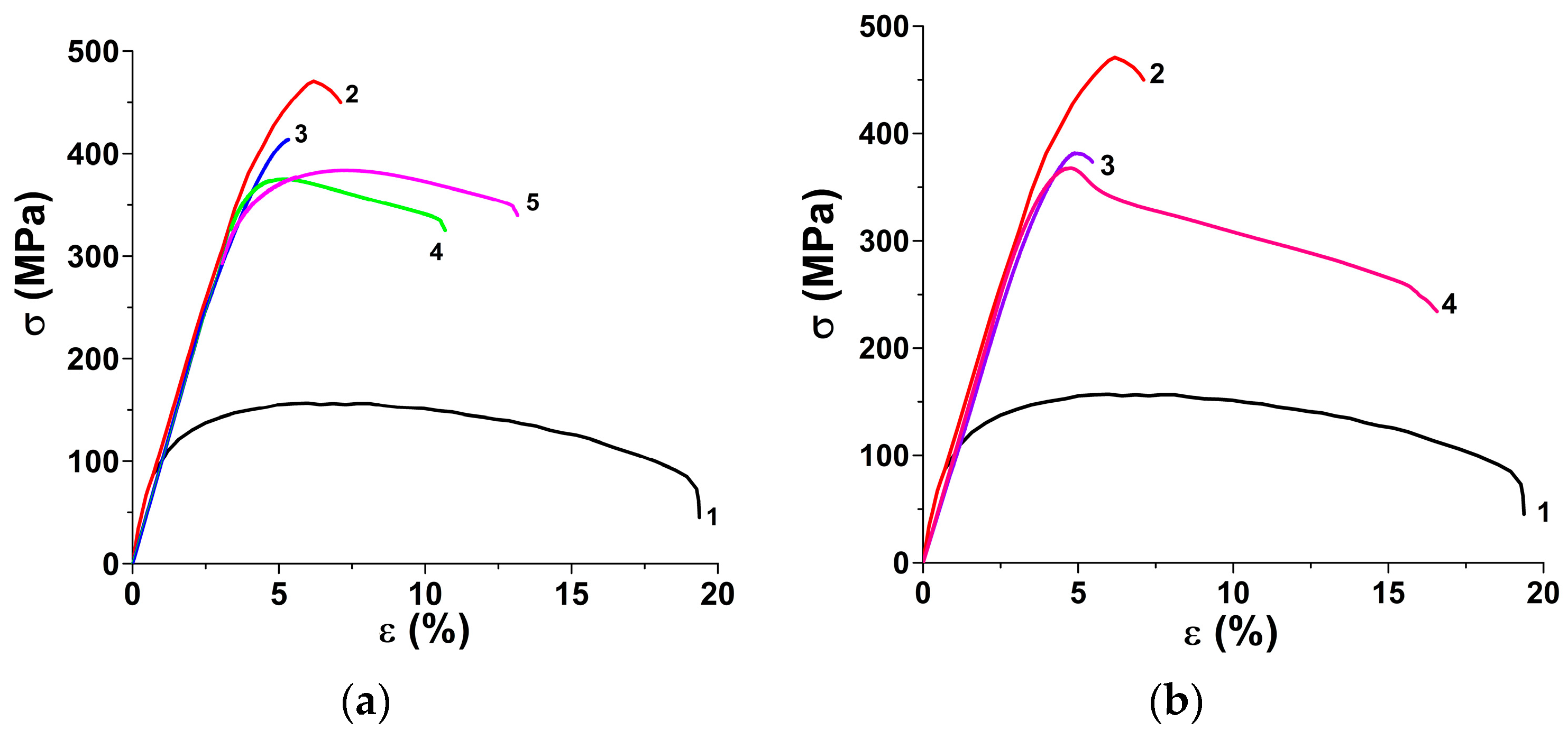
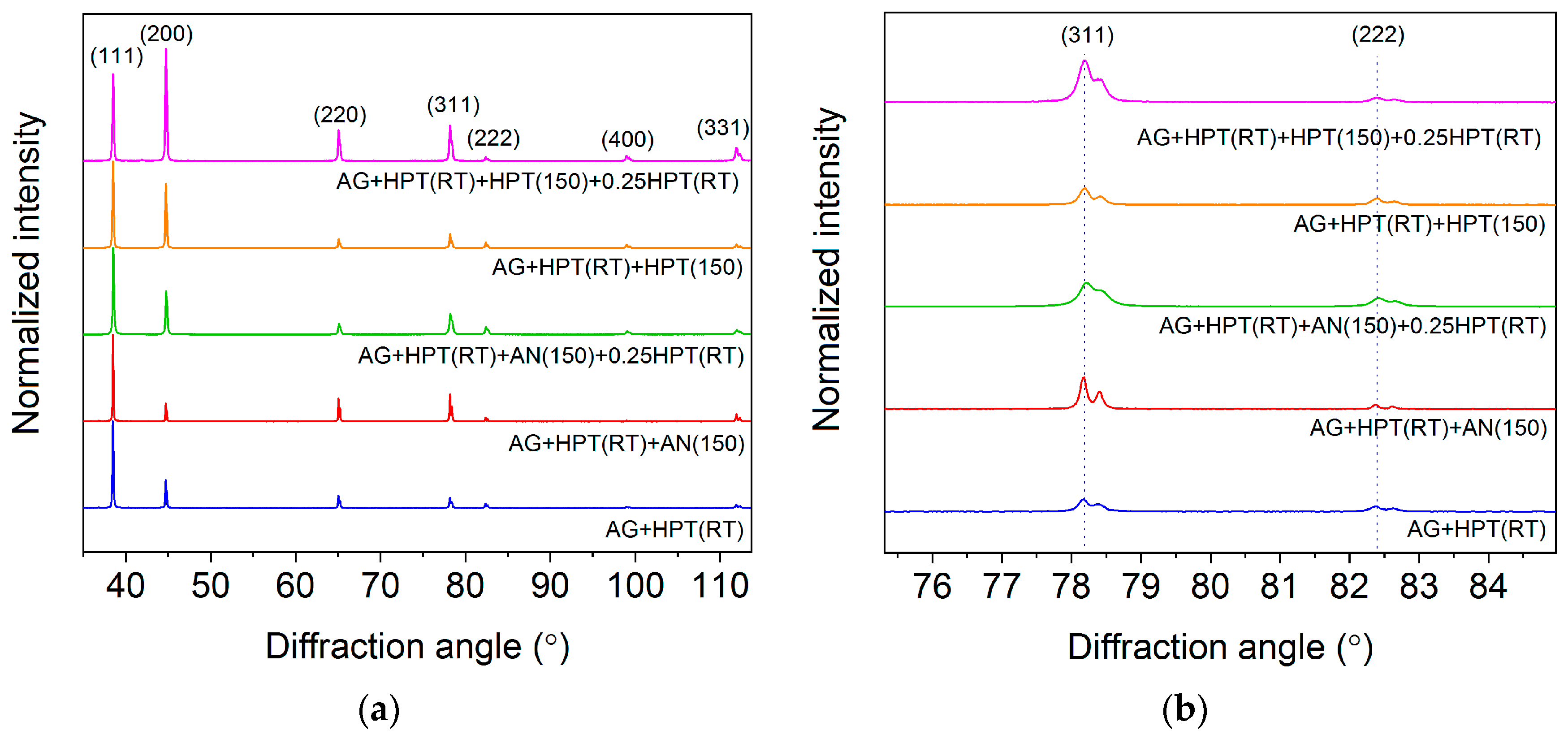
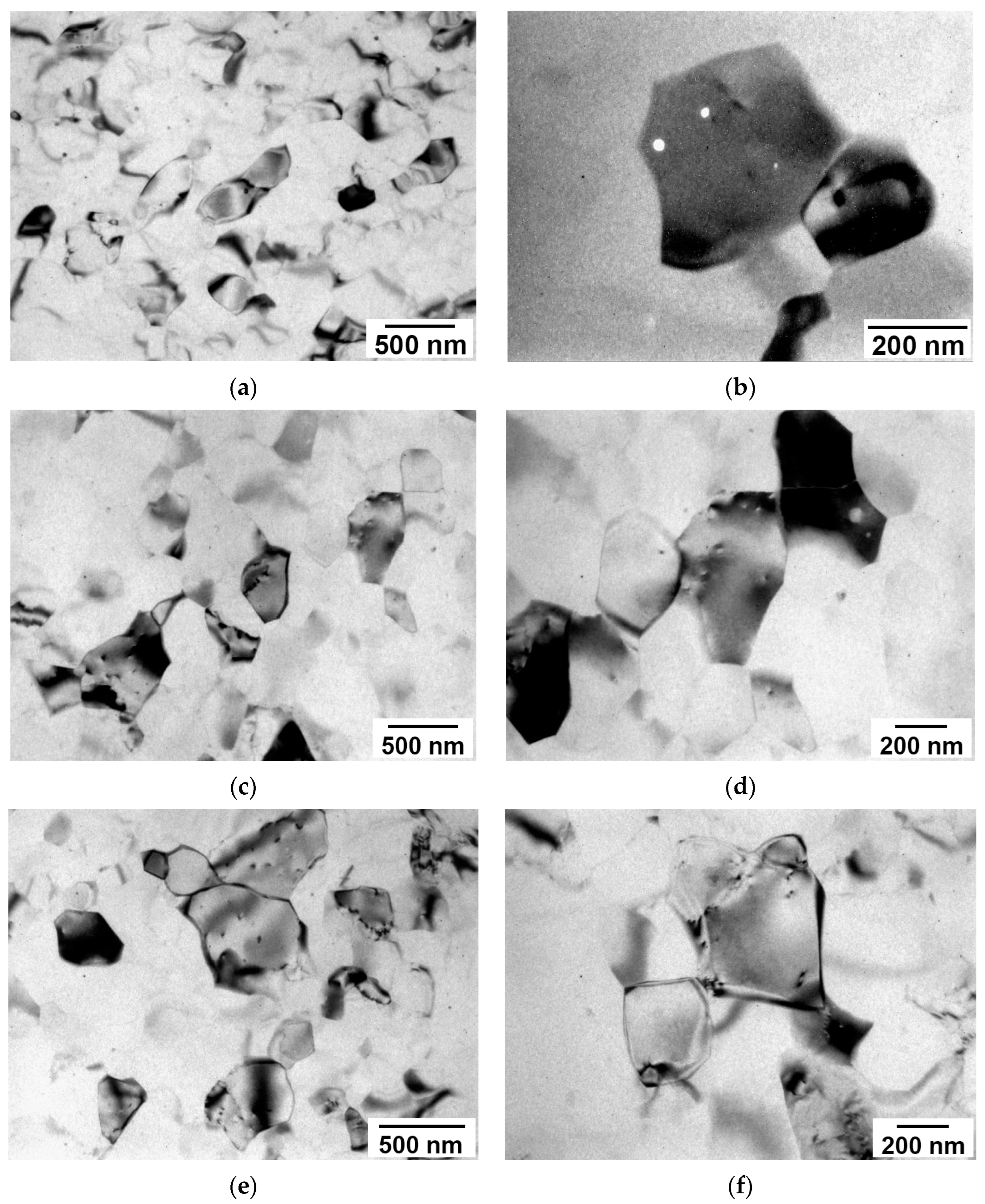
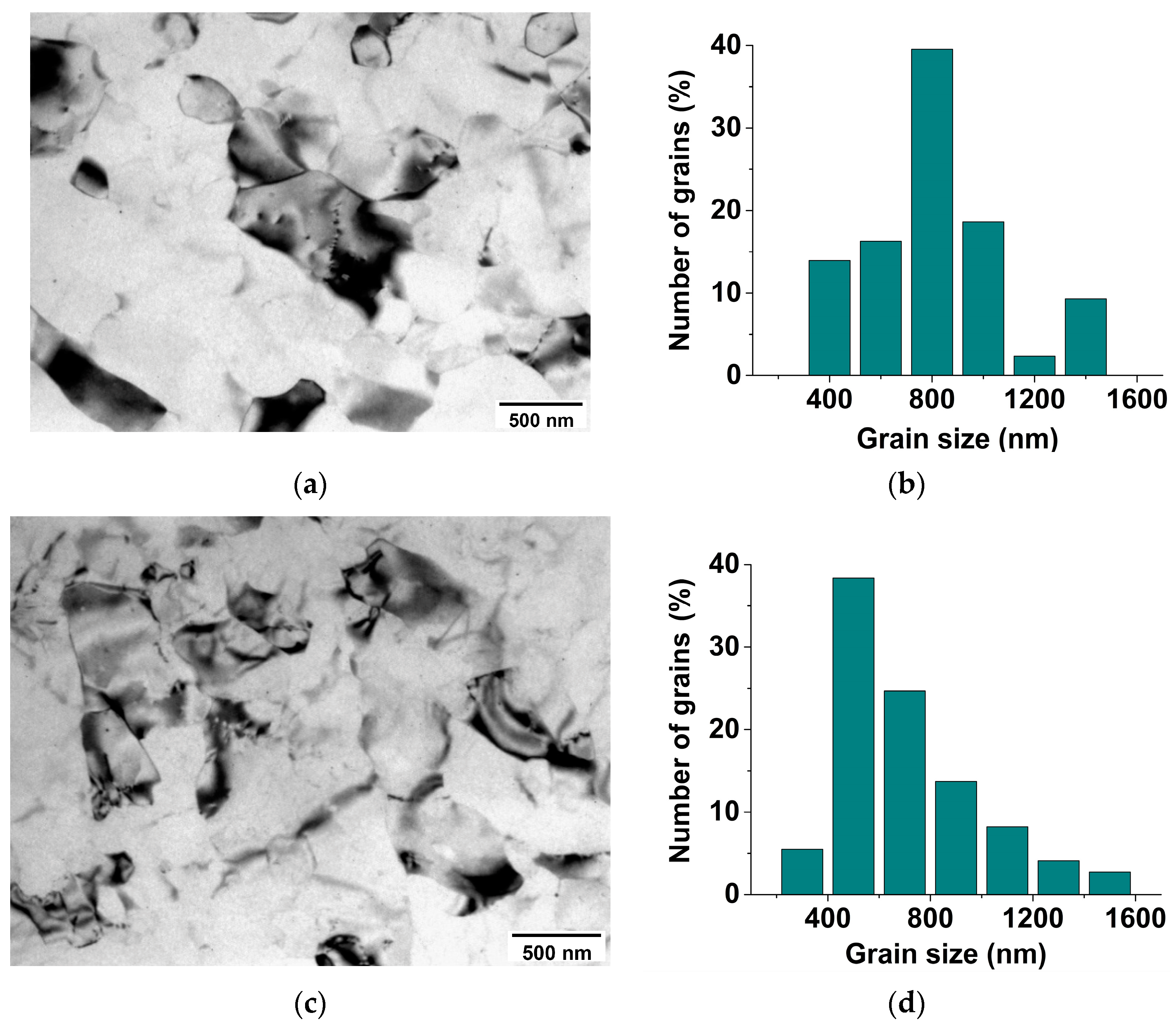
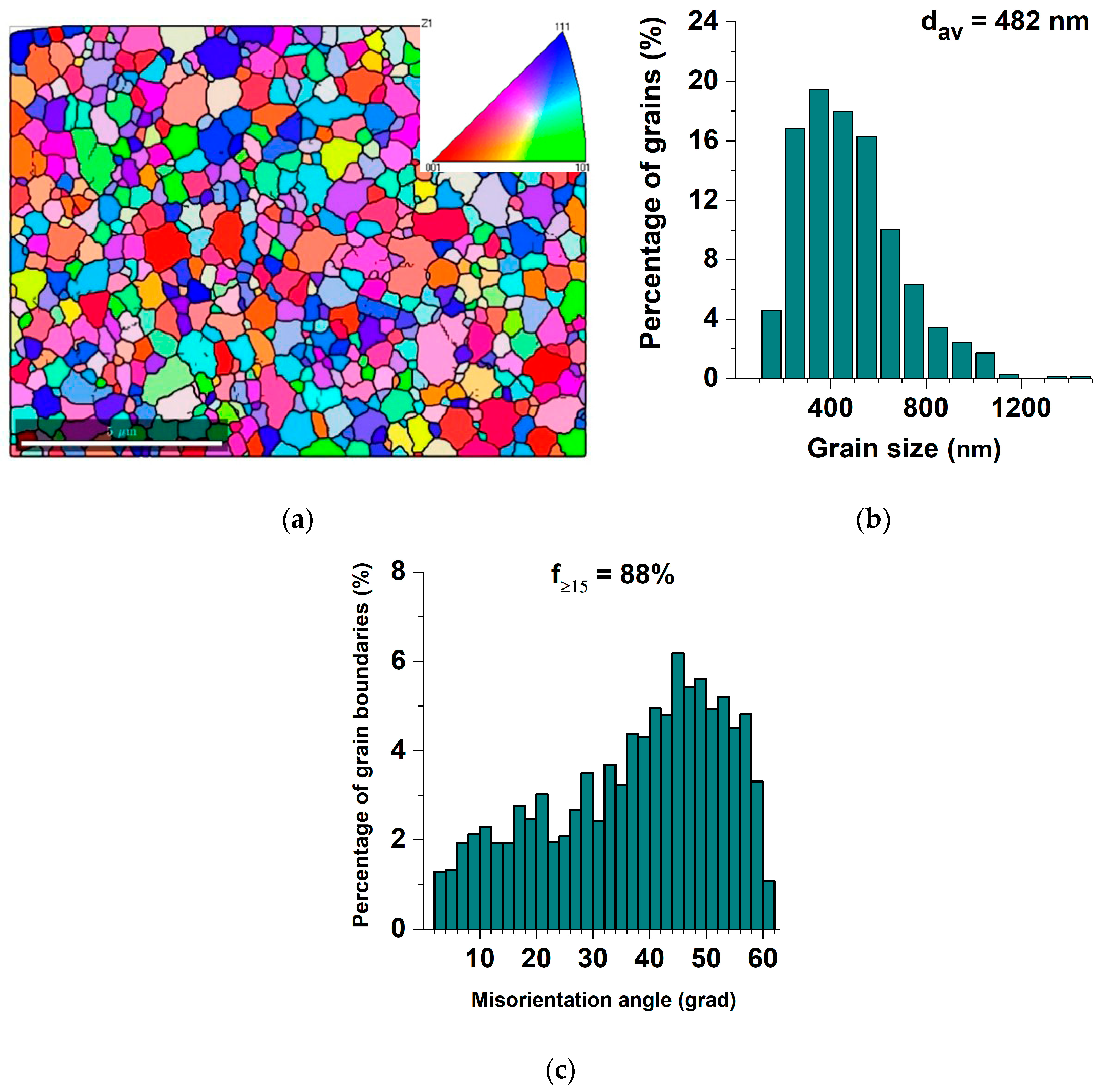
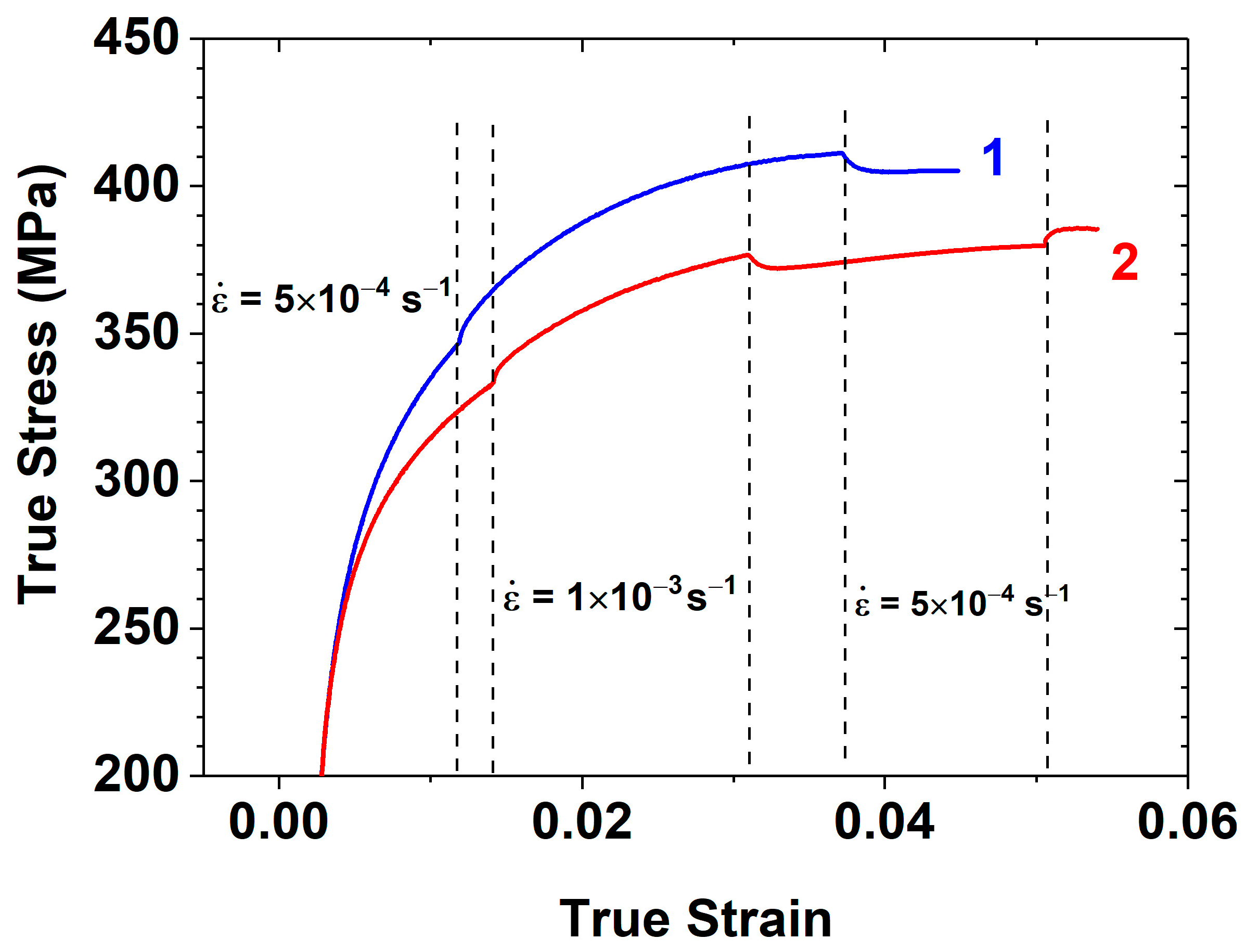
| State | Hv (MPa) | σ0.2 (MPa) | σUTS (MPa) | δ (%) | ω (MS/m) | ω (%IACS) |
|---|---|---|---|---|---|---|
| AG+HPT(RT) | 1240 ± 20 | 400 ± 10 | 465 ± 10 | ~3 | 30.00 ± 0.15 | 51.5 ± 0.3 |
| AG+HPT(RT)+AN(150) | 1063 ± 25 | 360 ± 10 | 400 ± 15 * | <1 | 30.60 ± 0.30 | 52.8 ± 0.3 |
| AG+HPT(RT)+AN(150)+0.25HPT(RT) | 990 ± 65 | 300 ± 10 | 375 ± 10 | ~7 | 30.15 ± 0.30 | 52.0 ± 0.2 |
| AG+HPT(RT)+AN(150)+0.75HPT(RT) | - | 285 ± 10 | 390 ± 10 | ~9 | 30.10 ± 0.30 | 52.0 ± 0.2 |
| AG+HPT(RT)+HPT(150) | 985 ± 65 | 350 ± 10 | 380 ± 10 * | <1 | 30.50 ± 0.10 | 52.5 ± 0.1 |
| AG+HPT(RT)+HPT(150)+0.25HPT(RT) | 960 ± 25 | 330 ± 10 | 370 ± 10 | ~15 | 30.60 ± 0.30 | 52.8 ± 0.5 |
| Material (State) | σ0.2 (MPa) | σUTS (MPa) | δ (%) | ω (%IACS) | Ref. |
|---|---|---|---|---|---|
| Al-0.53Mg-0.27Zr (Mg 0.53 wt.%~Mg 0.6 at.%) (AG+HPT(RT)+HPT(150)+ 0.25HPT(RT) state) | 330 | 370 | ~15 | 52.8 | The present work |
| Al-0.4Mg-0.2Zr AG + 6 passes ECAP-C at RT | 188 | 205 | 14.6 | 57.6 | [21] |
| Al-0.4Mg-0.2Zr ECAP-C + cold drawing | 249 | 267 | 2.4 | 57.1 | |
| Al-2%Fe HPT at RT (n = 20), HPT at 200 °C (n = 5) | 295 | 327 | 14.2 | 52.3 | [14] |
| Al-Zr (AT1) Cold drawing (CD) | - | 159–169 | ~2.0 | ≥60.0 | [39] |
| Al-Zr (AT2) Cold drawing (CD) | - | 225–248 | - | ≥55.0 | |
| Al-1.47Cu-0.34Zr (wt.%) (Cu 1.47 wt.%~Cu 0.63 at.%) (AG+HPT(RT)+AN(125)+ 0.25HPT state) | 330 | 465 | 11 | 47.2 | [13] |
| State | EBSD | TEM | XRD | |||||
|---|---|---|---|---|---|---|---|---|
| dav (nm) | f≥15 (%) | θav (°) | dav (nm) | a (Å) | DCDS (nm) | <ε2>1/2 (%) | Ldis × 1013 (m−2) | |
| AG+HPT(RT) | 400 ± 12 * | 88 * | 36 * | 450 ± 10 | 4.0526 ± 0.00007 | 196 ± 10 | 0.041 ± 0.002 | 2.5 |
| AG+HPT(RT)+AN(150) | 482 ± 15 | 88 | 37 | 500 ± 15 | 4.0527 ± 0.00001 | 362 ± 10 | 0.023 ± 0.002 | 0.77 |
| AG+HPT(RT)+AN(150)+ 0.25HPT(RT) | - | - | - | 480 ± 30 | 4.0519 ± 0.0001 | 143 ± 1 | 0.062 ± 0.002 | 5.3 |
| AG+HPT(RT)+HPT(150) | - | - | - | 825 ± 45 | 4.0523 ± 0.0001 | 452 ± 13 | 0.034 ± 0.001 | 0.90 |
| AG+HPT(RT)+HPT(150)+0.25HPT(RT) | - | - | - | 745 ± 40 | 4.0528 ± 0.0001 | 231 ± 8 | 0.051 ± 0.001 | 2.70 |
Disclaimer/Publisher’s Note: The statements, opinions and data contained in all publications are solely those of the individual author(s) and contributor(s) and not of MDPI and/or the editor(s). MDPI and/or the editor(s) disclaim responsibility for any injury to people or property resulting from any ideas, methods, instructions or products referred to in the content. |
© 2023 by the authors. Licensee MDPI, Basel, Switzerland. This article is an open access article distributed under the terms and conditions of the Creative Commons Attribution (CC BY) license (https://creativecommons.org/licenses/by/4.0/).
Share and Cite
Orlova, T.S.; Mavlyutov, A.M.; Sadykov, D.I.; Enikeev, N.A.; Murashkin, M.Y. Effect of Deformation-Induced Plasticity in Low-Alloyed Al-Mg-Zr Alloy Processed by High-Pressure Torsion. Metals 2023, 13, 1570. https://doi.org/10.3390/met13091570
Orlova TS, Mavlyutov AM, Sadykov DI, Enikeev NA, Murashkin MY. Effect of Deformation-Induced Plasticity in Low-Alloyed Al-Mg-Zr Alloy Processed by High-Pressure Torsion. Metals. 2023; 13(9):1570. https://doi.org/10.3390/met13091570
Chicago/Turabian StyleOrlova, Tatiana S., Aydar M. Mavlyutov, Dinislam I. Sadykov, Nariman A. Enikeev, and Maxim Yu. Murashkin. 2023. "Effect of Deformation-Induced Plasticity in Low-Alloyed Al-Mg-Zr Alloy Processed by High-Pressure Torsion" Metals 13, no. 9: 1570. https://doi.org/10.3390/met13091570
APA StyleOrlova, T. S., Mavlyutov, A. M., Sadykov, D. I., Enikeev, N. A., & Murashkin, M. Y. (2023). Effect of Deformation-Induced Plasticity in Low-Alloyed Al-Mg-Zr Alloy Processed by High-Pressure Torsion. Metals, 13(9), 1570. https://doi.org/10.3390/met13091570







